Lethal chytrid fungus discovered in Singapore.

The bullfrog is believed to be spreading chytrid fungus to wild frogs in Southeast Asia. Photo courtesy of WCS.
Scientists have documented a series of links between exotic frogs for trade and diseases in wild frogs in Southeast Asia, including the first documented case of the chytrid fungus—a virulent and lethal disease—in Singapore. According to researchers writing in a new study in EcoHealth, frogs imported into Southeast Asia as pets, food, or traditional medicine are very likely spreading diseases to wild populations.
Collecting samples of some 2,300 wild and captive frogs across four countries (Laos, Cambodia, Vietnam, and Singapore), researchers found that disease was widespread. Most worryingly, the researchers found chytrid fungus on two wild frogs and eleven captive frogs in Sinapore. In fact, four out of seven pet stores visited on the island nations sold frogs already infected with chytrid. They believe the American bullfrog is the primarily culprit.
“Since the American bullfrog is able to tolerate this pathogen, it may act as a carrier for spreading chytrid to the region when it is imported through commercial trade,” explains lead author Martin Gilbert with the Wildlife Conservation Society (WCS).
Chytrid fungus has spread rapidly around the world, decimating even remote and protected frog populations. It is believed to be responsible, at least in part, for a number of extinctions worldwide.
Fortunately the team didn’t detect chytrid fungus in Laos or Vietnam, but did find one imported frog—to be sold as food—that was carrying the disease. Another worrisome disease, ranavirus, was not discovered during testing.
However, the researchers also report that amphibians in Vietnamese frog farms were rife with skin lesions. Every frog tested—497 individuals—at 23 different facilities sported some type of skin disease from inflammation to missing digits.
“In light of the fact that this emerging infectious disease is now known to be spread by commercial trade, it is in everyone’s best interest to eliminate it from the trade in live animals before both the native amphibian populations of Southeast Asia are affected and before it completely decimates the commercial trade and people are unable to make a living,” said co-author David Bickford with the NUS Faculty of Science, adding, “This is not just about the frogs.”
Amphibians are among the world’s most endangered family groups: habitat loss, over-exploitation, invasive species, pollution, and disease has put nearly 41 percent of the world’s amphibians are considered threatened with extinction.
Related articles
Starry frog rediscovered after thought extinct for 160 years (photos)
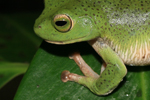
(03/07/2013) In 1853 Edward Frederick Kelaart, a physician and naturalist, collected a strange frog on the island of Sri Lanka then a British colony known as Ceylon. The specimen was a large shrub frog (about 2 inches or 5.5 centimeters long) with black-outlined white specks on lime-green skin. He dubbed it “starry” after its pale specks, but that was last anyone heard of it. Even the holotype—the body of the amphibian collected by Kelaart—went missing. Fast forward nearly 160 years—two world wars, Sri Lanka’s independence, and a man on the moon—when a recent expedition into Sri Lanka’s Peak Wilderness rediscovered a beguiling frog with pinkish specks.
Frogs radio-tracked for first time in Madagascar
![]()
(03/01/2013) Researchers have radio-tracked frogs for the first time in Madagascar. Attaching tiny radio transmitters weighing 0.3-0.35 grams (1/100 of an ounce) to 36 rainbow frogs (Scaphiophryne gottlebei), the research team tracked the movement of the colorful frogs through rugged canyons in Madagascar’s Isalo Massif. They found that the frogs have a short breeding period that occurs after the first intense rainfall at the start of the rainy season.
Popular pesticides kill frogs outright
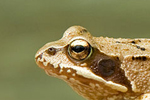
(01/28/2013) Commonly used agrochemicals (pesticides, fungicides and herbicides) kill frogs outright when sprayed on fields even when used at recommended dosages, according to new research in Scientific Reports. Testing seven chemicals on European common frogs (Rana temporaria), the scientists found that all of them were potentially lethal to amphibians. In fact, two fungicides—Headline and Captain Omya—wiped out the entire population of frogs at the recommended dosage. The study warns that agricultural chemicals could be having a large-scale and largely unrecorded impact on the world’s vanishing amphibians.
Common toads ravaged by killer disease in Portugal

(01/14/2013) The chytrid fungus—responsible for millions of amphibian deaths worldwide—is now believed to be behind a sudden decline in the common midwife toad (Alytes obstetricans), according to a new paper in Animal Conservation. Researchers have detected the presence of the deadly fungus in the Serra da Estrela, north-central Portugal, home to a population of the midwife toad.
New giant flying frog discovered near city of 9 million
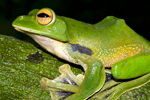
(01/09/2013) Jodi Rowley is no stranger to discovering new amphibians—she’s helped describe over 10 in her short career thus far—but still she was shocked to discover a new species of flying frog less than 100 kilometers from a major, bustling Southeast Asian metropolis, Ho Chi Minh City. Unfortunately, the new frog, dubbed Helen’s tree frog (Rhacophorus helenae), may be on the verge of extinction, according to the description published in the Journal of Herpetology.
New rare frog discovered in Sri Lanka, but left wholly unprotected
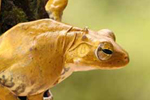
(11/05/2012) Sri Lanka, an island country lying off the southeast coast of India, has long been noted for its vast array of biodiversity. Islands in general are renowned for their weird and wonderful creatures, including high percentages of endemic species—and Sri Lanka, where scientists recently discovered a new frog species, is no exception.
Artificial ‘misting system’ allows vanished toad to be released back into the wild
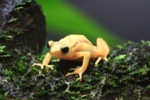
(11/01/2012) In 1996 scientists discovered a new species of dwarf toad: the Kihansi spray toad (Nectophrynoides asperginis). Although surviving on only two hectares near the Kihansi Gorge in Tanzania, the toads proved populous: around 17,000 individuals crowded the smallest known habitat of any vertebrate, living happily off the moist micro-habitat created by spray from adjacent waterfalls. Eight years later and the Kihansi spray toad was gone. Disease combined with the construction of a hydroelectric dam ended the toads’ limited, but fecund, reign.